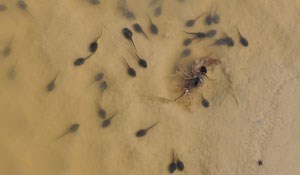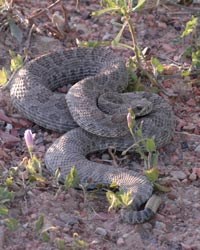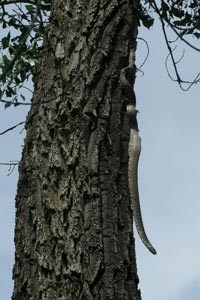|
Reptiles and amphibians are two different classes of animals. Examples of reptiles include snakes, lizards and turtles. Examples of amphibians are frogs, toads and salamanders. To learn more about them, let's compare and contrast! The most important trait they share is being cold-blooded. The scientific term is ectotherm: "ecto" means outside and "therm" means heat or temperature. A cold-blooded animal does not control its own body heat. In order to get warm or cool off it has to find sun or shade. 
NPS photo by Joe Bruce Amphibians Although both classes of animals are cold-blooded, there are many differences too! Amphibians go through very different stages of life. A frog will lay eggs in the water, and the babies that are born do not look like frogs at all! They look like strange fish with big heads and tiny tails. They have gills and breathe underwater. With a good habitat, these creatures begin to change after a few weeks. They grow legs and lose their tails, but they also grow lungs to breathe air. Soon the fish-like creature transforms into a frog! This change is called a metamorphosis (met-ah-morf-o-sis). Remember that word? It is the same process that turns nymphs into dragonflies! Amphibians spend most of their lives in or near water. This is because they need to lay their eggs in the water. The water also helps them breathe! An amphibian has thin skin which can absorb oxygen. This happens easier when their skin is wet. Reptiles Some reptiles stay near water too, but they do not need it as much as their amphibious cousins. Instead of a thin, moist skin, a reptile has scales to protect its body. Reptiles lay eggs, but they lay them on dry land. When the eggs hatch, a tiny version of the animal is born. It does not go through the metamorphosis which amphibians do. Some reptiles do not actually lay their eggs – they keep them inside their bodies until they hatch, then the babies come out! One example of this is the short-horned lizard. 
The ecosystem of the Badlands is a tough place for cold-blooded animals to survive. We only have a few types of reptiles, and even fewer amphibians. One of the common reptiles seen in the park are snakes! Many snakes, like the bullsnake and the racer, constrict their prey. They will bite a smaller creature and wrap around it, squeezing the prey until they are ready to swallow it whole! Other snakes, like the prairie rattlesnake, inject venom in their prey through their bite. All snakes are carnivorous, which means they eat other animals. Snakes eat creatures like insects, birds, mammals, and even other snakes! Although many people are afraid of snakes, they are rarely a threat to humans. Like most wildlife, snakes are actually afraid of people. They would only bite if they were surprised (like you stepped on it by accident) or if they were threatened (like you tried to pick it up). 
Snakes have different colors and patterns on their scales, and this helps them blend with their environment. This blending is called camouflage (cam-o-flahj). This is an adaptation they use to hide from prey and predators. The racer uses its speed to get away from danger. The bullsnake hisses if threatened. Sometimes it tries to copy, or mimic, the rattlesnake. It curls its body or vibrates its tail, even though it does not have a rattle! These abilities that help snakes survive are called adaptations. An adaptation can be something the snake does like mimic. This is a behavioral adaptation. It can also be something it is born with, like camouflage. This is a physical adaptation. That should wrap up our research on reptiles and amphibians! We have one more class of animals to research. Keep your thinking cap on, because we need to figure out how these animals fly! That's right - keep reading to learn about the birds of Theodore Roosevelt National Park. From here, you can go back to learn about other classes of wildlife. You can also return to the first Learn About the Park page. Go to the vocabulary page to review the blue words you learned here. |
Last updated: August 21, 2015
